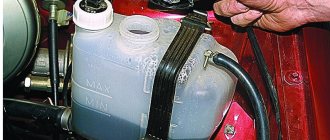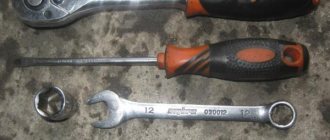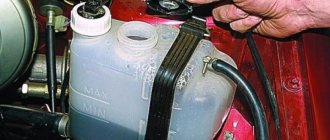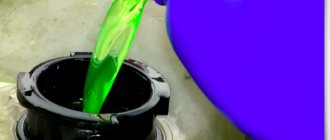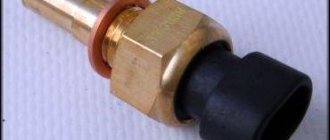To cool the engine in cars, a special liquid called antifreeze or antifreeze is used. The coolant is also used in the VAZ 2114 car and performs the functions of not only cooling the engine, but also heating the vehicle interior.
Many car owners are wondering whether it is necessary to change the coolant and when it should be replaced.
This article talks about replacing the coolant on a VAZ 2114 car, namely the timing of replacement, methods for replacing and flushing the internal combustion engine.
Do I need to change the coolant?
There are a huge number of different opinions about replacing the coolant, but only one of these statements is correct. The coolant definitely needs to be changed, but this can be done much less frequently than changing the same car oil.
The coolant on the VAZ 2114 should be replaced at 40,000 km, but no later than once every five years.
What to do if the car was bought secondhand and it is not known when the last replacement was carried out?
In this case, it is recommended to evaluate the condition of the fluid after purchase and, if necessary, replace it.
How to properly drain antifreeze from the system
If your VAZ 2114 is about to replace the antifreeze, it is not necessary to take the car to a service center. Having prepared several tools, you can do everything alone without the help of craftsmen. If there is an old coolant container left in the garage, it is perfect for draining waste material. The tools we need are:
- Wrenches for 8, 13 and 17.
- Flathead and Phillips screwdrivers.
- Cleaning rag.
Its viscosity depends on the temperature of the liquid. Therefore, in order for the antifreeze to drain better, work must begin with a warm engine. In the VAZ 2114 cooling system, hot antifreeze is also used to heat the interior. When draining, be sure to unscrew the heater radiator valve.
Step-by-step instruction
The work consists of the following stages:
- First of all, open the hood and remove the engine block protection.
- Remove the cap from the expansion tank.
Remove the cap from the coolant reservoir VAZ 2114
Open the plug at the bottom of the radiator and begin to drain the liquid
Open the plug on the engine and drain the antifreeze
The draining process is quite simple and will take you no more than an hour. After finishing the work, it will be useful to wipe the nearby parts from dirt.
Draining antifreeze (coolant) from the radiator and engine block on video
Coolant replacement should be carried out regularly twice a year or after 50 thousand km. The procedure does not take much time and does not require large financial costs. If you delay this, the cooling system will not be able to fully perform its function.
Source
Why change the coolant?
The fluid is replaced due to the loss of its properties of forming various reactions. If you do not change the coolant for a long time, it begins to react with parts of the cooling system, which leads to the formation of rust and can soon destroy parts of the engine cooling system, such as the radiator, thermostat or pump.
Mixing liquids with each other
There are two types of cooling fluids: antifreeze and antifreeze. Currently, antifreeze is very rarely used in modern cars; it has been replaced by antifreeze. Antifreeze is less toxic than antifreeze and does not react with aluminum.
Many are tormented by the question of whether it is possible to mix antifreeze and antifreeze with each other; there is no exact answer to this question. But if you accidentally mix antifreeze and antifreeze, nothing bad will happen, but you shouldn’t do this intentionally, but it’s better to pour into the system the liquid that was poured earlier.
Purpose of antifreeze
There is nothing difficult about completely draining the coolant from the car system. But before starting this process, you need to familiarize yourself with the structure and operating principles of the system as a whole.
ATTENTION! A completely simple way to reduce fuel consumption has been found! Don't believe me? An auto mechanic with 15 years of experience also didn’t believe it until he tried it. And now he saves 35,000 rubles a year on gasoline! Read more"
Antifreeze and antifreeze mean non-freezing technical fluid used in the car system not only to cool the engine and other units, regardless of climatic conditions, but also to lubricate certain elements and protect them from corrosive changes. Like all other technical fluids in a car, antifreeze deteriorates over time and loses its properties, which means that this material must be regularly replaced.
According to the rules, it is recommended to change the coolant at least once every three years, however, these dates may shift depending on how intensively the vehicle is used. If you constantly neglect this simple rule, then the recycled liquid will cease to function fully. The consequence of this will be constant overheating of the engine and all adjacent systems, as well as the appearance of corrosion.
Some craftsmen, in order to save money, dilute antifreeze with water, without even suspecting the serious damage they thereby cause to their own car. Thus, adding water causes the pump to jam , which does not receive the required amount of lubricant, as a result of which the belt may break or the gear teeth may be damaged. As a result, the distribution valves and the entire piston system as a whole may fail, so the decision to add water to the antifreeze is clearly wrong, and its consequences can be extremely disastrous.
Flushing the system
Flushing the system should be done if the coolant has traces of rust, as well as when changing antifreeze to antifreeze and vice versa.
As a washing liquid, you can use special products, distilled or boiled water. It should be noted that chemicals intended for washing SOD do a better job of the task, but their cost is much more expensive than distilled water.
Washing procedure
- It is necessary to drain the old fluid;
- Pour flushing fluid into the system;
- Start the engine and let it run for 30 minutes;
- We drain the liquid; if it has traces of rust and is quite dirty, the procedure must be repeated;
Replacing antifreeze and antifreeze on a VAZ 2114
First of all, you need to remember that replacement occurs only in a cooled car, where the engine will be cold. For your own safety, it is prohibited to carry out any actions if the mechanisms are not cooled down.
The eight-valve engine of a vehicle such as the VAZ 2114 has a liquid volume of one and a half liters. Therefore, manufacturers recommend using a volume of no more than eight liters to fill the required barrel with antifreeze or antifreeze.
To completely fill it, two small canisters of five liters each, or one large one containing ten liters of solution, will be enough. The liquid must be mixed according to the instructions included with the specific type of cooler.
Do not forget that if the antifreeze has not been used completely, then you need to add the same type that was used last time. Other manufacturers will not be suitable. It may happen that the model of the previous cooler may be unknown. In this case, special “additional” solvents are sold that will be compatible with other antifreezes (not with antifreeze). It is rated G12.
Coolant replacement
Replacement should only be done when the engine is cold to ensure safety from burns. Also, before replacing, it is necessary to evaluate what was previously filled.
Determination of previously filled liquid
The first step is to make sure there is liquid in the system. If there is little of it or it is completely absent in the expansion tank, then there is a leak somewhere. Before replacing and adding new coolant, all fluid leaks must be repaired. To do this, we inspect all areas where liquid circulates.
Next, we determine what is flooded.
The car may be filled with: antifreeze, antifreeze and water. All these liquids are different from each other and identifying them is quite simple.
- If the liquid in the expansion tank is red or green, it means there is antifreeze in the system.
- If there is blue liquid in the tank, then the system is filled with antifreeze.
- If the liquid in the expander looks clear, it means it is water.
It happens that due to severe contamination it is difficult to determine what is in the system; in this case, it is recommended to drain the liquid from the system and rinse it. Then fill in high-quality coolant for the cooling system.
It is highly not recommended to fill in water, as it can freeze at subzero temperatures and damage the engine, which, by the way, can lead to serious damage.
Draining liquid
- To drain the liquid, you will need a container with a volume of up to 10 liters. We drain the liquid from the system; to do this, unscrew the cap on the radiator and drain the coolant into a container prepared for this.
- We tighten the plug and, if necessary, do a flush, then drain the flushing liquid again.
- Fill with clean coolant and start the engine.
- The work process is completed.
ABOUT THE PRINCIPLE OF OPERATION OF THE COOLING SYSTEM
The engines of the VAZ 2113, 2114 and 2115 family of cars operate in conjunction with a closed-type liquid cooling system. There are special channels in the engine cylinder block through which coolant, or coolant for short, circulates, which is used as antifreeze, antifreeze or water. Moving through the block, the coolant takes away excess heat and enters the radiator for cooling.
Studies of the operation of internal combustion engines have shown that the normal temperature for optimal engine operation should be 900C. To maintain a constant temperature, a thermostat is installed in the system. During engine operation, it redirects the coolant flow to the radiator for cooling, or again to the cylinder block.
Forced coolant circulation in the system is provided by a pump, which is driven by a drive belt from a pulley on the engine crankshaft. The heated coolant flows through the pipes into the radiator for cooling. It comes from the flow of oncoming air, and if it is not enough, then the electric fan turns on. Also, hot coolant enters the heater radiator to heat the engine compartment, and its excess during thermal expansion is sent to the expansion tank.
Useful tips
Replacing the coolant on a VAZ 2114 is not difficult, but it also requires some skills in car repair. The work will be easier and faster, and the result will be much better if you follow the following tips:
- Work must be carried out on a cold engine;
- Before filling in new coolant, it is recommended to flush the system;
- It is not recommended to pour water into the system;
- Before choosing antifreeze and antifreeze, it is best to give preference to antifreeze;
- If you mix antifreeze and antifreeze, nothing will happen, but you shouldn’t do this on purpose;
- After replacing the coolant, it is necessary to warm up the internal combustion engine to operating temperature and check the fluid level, adding fluid if necessary.
WHAT'S IN THE COOLING SYSTEM
Antifreeze or antifreeze is used to cool engines. Let's find out in more detail about these liquids, and what is better to use antifreeze or antifreeze on the VAZ 2114. This separate name for coolant is used only by drivers in Russia and CIS countries. At their core, they are the same chemical substance. However, there are still slight differences in these substances, which affect the operation and components of the engine.
Experts recommend pouring antifreeze into the cooling system of foreign cars, while antifreeze is more suitable for cars of the Russian automobile industry. Replacing antifreeze with antifreeze is possible, there will be no harm from it. You just need to thoroughly rinse the cooling system with distilled water. The question of which antifreeze is best to pour into a VAZ 2114 needs to be decided by the car owner himself.
A few words about the advantages of antifreeze over antifreeze:
- Higher cooling efficiency;
- Increased service life;
- More effective protection of aluminum parts at high temperatures;
- The pump resource increases;
- Higher ability to protect against cavitation in cylinders;
- Better compatibility when working with rubber, plastic and other materials of cooling system parts;
- Higher environmental friendliness in use.
When purchasing coolant, the buyer wants to know at what temperatures it is intended to operate. The consumer is informed about this by the marking on the coolant container. If there is an inscription “Antifreeze 65”, then this liquid can be used at ambient temperatures not lower than -650C. You can also check the density of the liquid yourself with a hydrometer. It is allowed to add distilled water to the coolant during vehicle operation, since it is this that evaporates at high temperatures.


